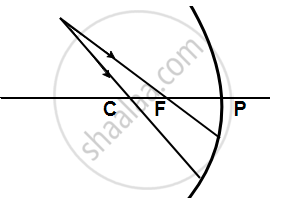Advertisements
Advertisements
Question
What do you understand by the focus and focal length of a spherical mirror? Show them on the separate diagrams for each of a concave mirror and a convex mirror.
Solution
FOCUS: For concave mirror
“A point on the principal axis at which the light rays incident parallel to the principal axis meet after reflection from the mirror.
FOCAL LENGTH: “The distance between focus and pole”. FP is focal length for a concave mirror.

FOCUS: For Convex mirror
“A point on its principal axis at which the light rays incident parallel to the principal axis appear to meet after reflection from the mirror”.
FOCAL LENGTH: “The distance between P and F is F.L.”

APPEARS IN
RELATED QUESTIONS
One half of a convex lens of focal length 10 cm is covered with a black paper. Can such a lens produce an image of a complete object placed at a distance of 30 cm from the lens? Draw a ray diagram to justify your answer. A 4 cm tall object is placed perpendicular to its principal axis of a convex lens of focal length 20 cm. The distance of the object from the lens is 15 cm. Find the nature, position and the size of the image.
Define the following term in the context of spherical mirrors:- Principal axis
The shiny outer surface of a hollow sphere of aluminium of radius 50 cm is to be used as a mirror:
What will be the focal length of this mirror?
Write the formula for a lens connecting image distance (v), object distance (u) and the focal length (f). How does the lens formula differ from the mirror formula?
Name the kind of mirror used to obtain
(a) a real and enlarged image
(b) a virtual and enlarged image
(c) a real and diminished image, and
(d) a virtual and diminished image.
Draw suitable diagrams to illustrate the action of (i) concave mirror and (ii) convex mirror on a beam of light incident parallel to the principal axis.
AB is the object, A1B1 is its image. MM' is the position of the mirror. Complete the ray diagram and find the position of the center of curvature and focus of the mirror. Also, measure the focal length.

Complete the following diagrams shown in the below figure by drawing the reflected ray for each incident ray.

